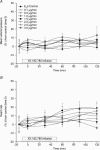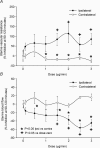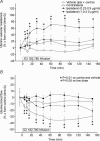Uterine blood flow responses to ICI 182 780 in ovariectomized oestradiol-17beta-treated, intact follicular and pregnant sheep
- PMID: 15774510
- PMCID: PMC1464500
- DOI: 10.1113/jphysiol.2005.086439
Uterine blood flow responses to ICI 182 780 in ovariectomized oestradiol-17beta-treated, intact follicular and pregnant sheep
Abstract
Oestrogen dramatically increases uterine blood flow (UBF) in ovariectomized (Ovx) ewes. Both the follicular phase and pregnancy are normal physiological states with elevated levels of circulating oestrogen. ICI 182 780 is a pure steroidal oestrogen receptor (ER) antagonist that blocks oestrogenic actions in oestrogen-responsive tissue. We hypothesized that an ER-mediated mechanism is responsible for in vivo rises in UBF in physiological states of high oestrogen. The purpose of the study was to examine the effect of an ER antagonist on exogenous and endogenous oestradiol-17beta (E2beta)-mediated elevations in UBF. Sheep were surgically instrumented with bilateral uterine artery blood flow transducers, and uterine and femoral artery catheters. Ovx animals (n = 8) were infused with vehicle (35% ethanol) or ICI 182 780 (0.1-3.0 microg min(-1)) into one uterine artery for 10 min before and 50 min after E2beta was given (1 microg kg(-1) I.V. bolus) and UBF was recorded for an additional hour. Intact, cycling sheep were synchronized to the follicular phase using progesterone, prostaglandin F2alpha(PGF2alpha) and pregnant mare serum gonadotrophin (PMSG). When peri-ovulatory rises in UBF reached near peak levels, ICI 182 780 (1 or 2 microg (ml uterine blood flow)-1) was infused unilaterally (n = 4 sheep). Ewes in the last stages of pregnancy (late pregnant ewes) were also given ICI 182 780 (0.23-2.0 microg (ml uterine blood flow)-1; 60 min infusion) into one uterine artery (n = 8 sheep). In Ovx sheep, local infusion of ICI 182 780 did not alter systemic cardiovascular parameters, such as mean arterial blood pressure or heart rate; however, it maximally decreased ipsilateral, but not contralateral, UBF vasodilatory responses to exogenous E2beta by approximately 55-60% (P < 0.01). In two models of elevated endogenous E2beta, local ICI 182 780 infusion inhibited the elevated UBF seen in follicular phase and late pregnant ewes in a time-dependent manner by approximately 60% and 37%, respectively; ipsilateral >> contralateral effects (P < 0.01). In late pregnant sheep ICI 182 780 also mildly and acutely (for 5-30 min) elevated mean arterial pressure and heart rate (P < 0.05). We conclude that exogenous E2beta-induced increases in UBF in the Ovx animal and endogenous E2beta-mediated elevations of UBF during the follicular phase and late pregnancy are partially mediated by ER-dependent mechanisms.
Figures





Similar articles
-
Endothelial vasodilator production by ovine uterine and systemic arteries: ovarian steroid and pregnancy control of ERalpha and ERbeta levels.J Physiol. 2005 May 15;565(Pt 1):85-99. doi: 10.1113/jphysiol.2005.085753. Epub 2005 Mar 17. J Physiol. 2005. PMID: 15774511 Free PMC article.
-
Nitric oxide contributes to estrogen-induced vasodilation of the ovine uterine circulation.J Clin Invest. 1996 Nov 1;98(9):2158-66. doi: 10.1172/JCI119022. J Clin Invest. 1996. PMID: 8903336 Free PMC article.
-
Large conductance Ca2+-activated and voltage-activated K+ channels contribute to the rise and maintenance of estrogen-induced uterine vasodilation and maintenance of blood pressure.Endocrinology. 2012 Dec;153(12):6012-20. doi: 10.1210/en.2012-1717. Epub 2012 Oct 15. Endocrinology. 2012. PMID: 23070547 Free PMC article.
-
Control of uterine and ovarian blood flow throughout the estrous cycle and pregnancy of ewes, sows and cows.J Anim Sci. 1982;55 Suppl 2:32-42. J Anim Sci. 1982. PMID: 6765316 Review.
-
Mechanisms regulating angiotensin II responsiveness by the uteroplacental circulation.Am J Physiol Regul Integr Comp Physiol. 2001 Oct;281(4):R1025-40. doi: 10.1152/ajpregu.2001.281.4.R1025. Am J Physiol Regul Integr Comp Physiol. 2001. PMID: 11557608 Review.
Cited by
-
[Regulation of uterine blood flow. I. Functions of estrogen and estrogen receptor α/β in the uterine vascular endothelium during pregnancy].Rev Chil Obstet Ginecol. 2014;79(2):129-139. doi: 10.4067/S0717-75262014000200011. Rev Chil Obstet Ginecol. 2014. PMID: 26113750 Free PMC article. Spanish.
-
Rad-mediated inhibition of CaV1.2 channel activity contributes to uterine artery haemodynamic adaptation to pregnancy.J Physiol. 2024 Dec;602(24):6729-6744. doi: 10.1113/JP287334. Epub 2024 Nov 29. J Physiol. 2024. PMID: 39612361
-
Estrogen Receptors and Estrogen-Induced Uterine Vasodilation in Pregnancy.Int J Mol Sci. 2020 Jun 18;21(12):4349. doi: 10.3390/ijms21124349. Int J Mol Sci. 2020. PMID: 32570961 Free PMC article. Review.
-
ICI 182,780 Attenuates Selective Upregulation of Uterine Artery Cystathionine β-Synthase Expression in Rat Pregnancy.Int J Mol Sci. 2023 Sep 21;24(18):14384. doi: 10.3390/ijms241814384. Int J Mol Sci. 2023. PMID: 37762687 Free PMC article.
-
Pregnancy upregulates angiotensin type 2 receptor expression and increases blood flow in uterine arteries of rats.Biol Reprod. 2018 Nov 1;99(5):1091-1099. doi: 10.1093/biolre/ioy130. Biol Reprod. 2018. PMID: 29860295 Free PMC article.
References
-
- Al-Matubsi HY, Fairclough RJ, Jenkin G. Oestrogenic effects of ICI 182,780, a putative anti-oestrogen, on the secretion of oxytocin and prostaglandin F2 alpha during oestrous cycle in the intact ewe. Anim Reprod Sci. 1998;51:81–96. 10.1016/S0378-4320(98)00068-2. - DOI - PubMed
-
- Carnegie JA, Robertson HA. Conjugated and unconjugated estrogens in fetal and maternal fluids of the pregnant ewe: a possible role for estrone sulfate during early pregnancy. Biol Reprod. 1978;19:202–211. - PubMed
-
- Chambliss KL, Yuhanna IS, Anderson RG, Mendelsohn ME, Shaul PW. ERbeta has nongenomic action in caveolae. Mol Endocrinol. 2002;16:938–946. - PubMed
-
- Chen DB, Bird IM, Zheng J, Magness RR. Membrane estrogen receptor-dependent extracellular signal-regulated kinase pathway mediates acute activation of endothelial nitric oxide synthase by estrogen in uterine artery endothelial cells. Endocrinology. 2004;145:113–125. - PubMed
Publication types
MeSH terms
Substances
Grants and funding
LinkOut - more resources
Full Text Sources
Miscellaneous

